Introduction 1 - 5
More information about the Spanning Tree protocol is included in
Appendix B.
Traffic Localization
The Bridge Module is a packet store-and-forward device that receives all
packets and, if necessary, forwards them from the subnetwork on one side
of the bridge to the subnetwork on the other side. The Bridge Module also
acts as a packet filter, filtering packets based upon local destination
addresses.
Filtering can isolate high traffic subnetworks from the rest of the LAN. For
example, if the systems and servers in a cluster or subnetwork usually
communicate with each other and rarely communicate with systems on
other LANs, the Bridge Module does not forward that traffic to the
extended LAN, except as needed.
The Bridge Module allows you to set up to 100 device addresses to be
always forwarded to or never forwarded to. This can be used to keep
sensitive subnetwork traffic local at all times. Enhanced network
performance is also gained through the use of this feature.
Topology Switching
Topology switching enables you to automatically change the extended LAN
topology without having to recable or take the network down. Bridging
functionality lets you switch between any two ONline channels or between
any ONline channel and an external Ethernet network. Topology switching
is performed using the Bridge Module's command interface. The Bridge
Module automatically recalculates the Spanning Tree to reorient the bridge
in the network.
Automatic Address Learning
When attached to a subnetwork, the Bridge Module dynamically learns the
addresses of all nodes on the subnetwork - thus it is called a learning


















